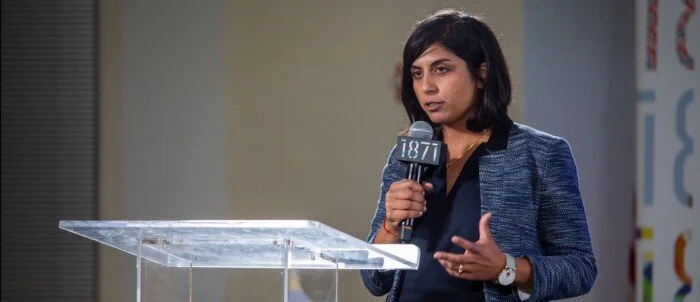By Lily Wang
The final event in Impact Engine's 10th annual Chicago Impact Investing Showcase took place on April 26th. Concluding a series that explored various types of impact investors, this session focused on private funds. It explored the important role funds play in aggregating and deploying capital on behalf of the many actors discussed in prior sessions such as governments, individuals, and foundations. Jessica Droste Yagan served as moderator and provided introductory remarks, putting into context how funds might define their impact strategy within the 5P Framework.
The ensuing discussion offered insights from both fund managers and founders, demonstrating the ways in which capital flows through private funds to generate impact. Tasha Seitz, Partner at Impact Engine, shared how Impact Engine has approached impact investing over the past ten years, across six funds, 68 companies, and $124M in AUM. Tasha explained how Impact Engine invests in companies where financial returns and impact are expected to grow hand-in-hand, and how they seek impact commitments through mechanisms such as board seats, side letters, impact theses, and impact metrics. She shared examples of such investments across Impact Engine's three primary focus areas:
Economic Opportunity: BookNook is a virtual literacy and math tutoring platform that has enabled students to record a 1.0 reading level improvement
Sustainability: Measurabl is a sustainability performance platform that has provided close to 12M gross sq. footage of commercial real estate with actionable sustainability insights
Health Equity: Workit Health is an end-to-end virtual solution for addiction treatment with 1.5K customers, of which 95% reported an improvement in quality of life
Tasha then invited two Chicago-based entrepreneurs to share their views on how working with impact funds has enabled them to achieve their intended impact. Feyi Olopade Ayodele, CEO of Cancer IQ, shared an overview of how her company aims to end cancer with early detection and prevention. She explained how Cancer IQ has been able to help patients, health providers and diagnostic partners stay ahead of cancer with their precision prevention platform, demonstrating a 16% increase in early diagnosis. Feyi shared that working with Impact Engine has been instrumental to realizing her vision of Cancer IQ as a broad network that engages all parts of healthcare. While traditional VC firms may have pushed Cancer IQ to consider a different path due to the slow regulatory environment of the healthcare industry, working with impact investors allowed Feyi to stay true to her mission. Cancer IQ is now integrated across 40 health systems, 200 hospitals, and recently closed a Series B round.
Next, Mindi Knebel, founder and CEO of Kaizen Health, shared how working with investors like Impact Engine has enabled her to expand Kaizen Health's impact reach. The company had its start as a platform connecting healthcare with transportation. However, the company has since expanded into additional projects by leveraging its platform to increase public transit accessibility, reduce infant mortality through a maternal transportation program, improve food security during the COVID pandemic, and offer up to 7,000 monthly rides for Chicago Public Schools. Mindi thanked Impact Engine for believing in Kaizen from the start, and for helping expand Kaizen's reach across a broad range of social determinants of health.
Andy Zopp, Managing Partner of CAST US (Cleveland Avenue State Treasurer Urban Success Fund), then took the stage to share more about how CAST US is working to bridge the capital and resource gap impacting Black, Latinx, and female entrepreneurs in Chicago's South and West Side. The $71M portfolio launched last year and has already invested in 12 high-impact companies led by historically underserved founders. Andy invited two of these entrepreneurs to share how working with CAST US has enabled them to not only access catalytic capital, but also receive support and empowerment from Cleveland Avenue's entrepreneurial development expertise.
Sergio Suarez, CEO of Tackle AI, began with a powerful story of how he looks forward to the day when founders and investors from the Latinx community are common in the VC world. He expressed appreciation for funds like CAST US for driving towards that vision and supporting diverse founders. Sergio explained how Tackle AI is transforming the way companies use and manage unstructured data. Tackle AI enables the redaction and extraction of data in documents at higher speeds, with greater accuracy, and at a fraction of the traditional cost by combining deep learning with core logic engines. Tackle AI has experienced rapid growth, tripling their valuation in the past 8 months, and anticipating a 4x increase in revenue for this year.
Lastly, AYO Foods co-founder Perteet Spencer shared how CAST US' support has been instrumental to AYO's success in bringing West African foods to a broader audience. AYO aims to celebrate the many flavors of the diaspora, while enriching nutritional value through diversified crops and creating lasting economic value through farm partnerships. Since launching in July 2020, they have tripled their frozen food line from three to nine items, and have expanded their distribution reach 90x, growing from 50 doors with Whole Foods to 4,700 doors across several major retailers. They also built their first farm in Liberia in partnership with Girl Power Africa, offering new economic outcomes for women in the region.
The speakers showcased just a small slice in the diversity of impact that private fund investments make possible. They each emphasized the unique value that impact investors bring to the table, and the ways in which impact-aligned founders can maximize their reach with similarly impact-aligned capital. Importantly, they demonstrated how there is no need for trade-offs between financial and social returns in today's ecosystem. Jessica closed out the session by sharing the current landscape of impact investing funds in Chicago, with over 30 firms investing across various asset classes, themes, geographies, and the 5Ps. On behalf of Impact Engine, Jessica expressed appreciation for the continued momentum and growth of this landscape over time, and excitement for what is yet to come for impact investing.
Find more sessions on the 2022 Chicago Impact Investing Showcase page.
Information presented in this document is intended solely for informational purposes and should not be interpreted as a recommendation or offer of securities or any other financial instrument. Unless otherwise indicated, the information contained herein is current as of the date of publication of this document and is believed to be reliable and has been obtained from sources believed to be reliable, but no representation or warranty is made, expressed or implied, with respect to the fairness, correctness, accuracy, reasonableness or completeness of the information and opinions.







